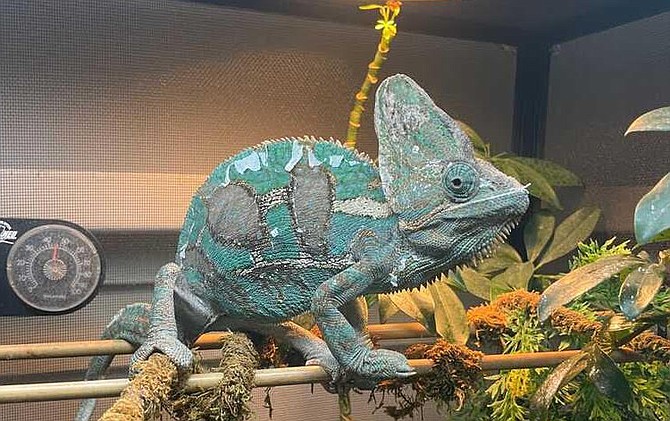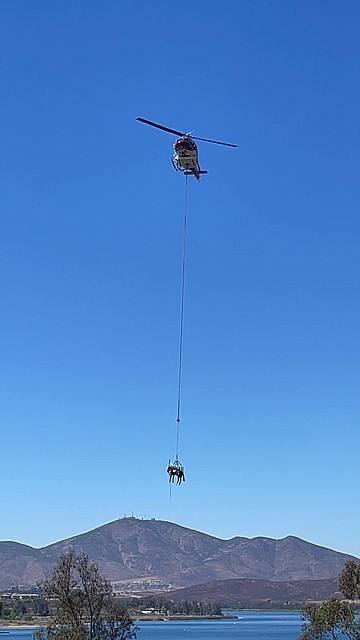 Facebook
Facebook
 X
X
 Instagram
Instagram
 TikTok
TikTok
 Youtube
Youtube

On July 11, Camo, a five-year-old veiled chameleon, escaped from his indoor and outdoor cage in a Mission Hills home.
"I live next to a row of Juniper trees, so he will likely climb to the sunniest spot at the top of the trees," Paige Martin explained to her neighbors on social media. "He will be hard to spot in the greenery, but he turns bright green and yellow when he sleeps, so it will be easier to spot him at night. I'm asking you all to please keep an eye out for him."
Martin, a 28-year-old boat charter coordinator, put up fliers between Washington Street and University Avenue in her neighborhood and passed out photos of her 6-8 inch cone-headed chameleon within their 2-story apartment complex. One neighbor offered to fly a drone above, and another provided binoculars to help find Camo.
Then, later that Monday, Martin's neighbor upstairs yelled, "Paige, I see Camo!"
Martin ran upstairs to look out her neighbor's window, where she could see Camo hanging out on a branch from one of the Juniper trees.
"It's quite a way down from where he escaped," Martin recounted to me. "He is like my child."
Martin said she then ran to the San Diego Fire-Rescue Department Station 8 on Goldfinch by Washington Street. "I rang their emergency bell and let them know what was going on. I told them, 'If Camo were a cat, they would definitely do it.' So they immediately followed me back to my apartment with their ladder."
Martin sent me photos of the rescue. In the images, a fireman wearing a navy blue t-shirt and orange gloves climbs a ladder up into the Juniper tree's branches and leaves, overhanging about 10 feet away from their apartment complex. Another fireman standing below holds the ladder still.

"And the amazing men at the SDFD saved him for me!" Martin concluded.
The San Diego Fire-Rescue Department responded to 67 animal rescues in the last couple of years, according to the San Diego Fire-Rescue Foundation. Other rescues involved birds and farm animals trapped in wells, drains, fences, and ditches or stranded in floodwaters. Animals have fallen down cliffs and hillsides and even been rescued from car engines and dashboards.
Then some cats get stuck in trees, like Camo the chameleon almost two weeks ago.
The non-profit's site adds that the fire department made seven horse rescues where five were ground lifted — and the other two rescued via a helicopter.
At about noon on June 24, Customs and Border Protection requested San Diego Fire-Rescue Department to the Lower Otay Reservoir to help rescue a CBD agent and his horse, General. The two were stung by a swarm of bees and needed medical attention. The Chula Vista Police Department assisted as well. Initially, the border patrol agent was extricated using SDFD's Copter 1 and transported to a local hospital.
Then a veterinarian had to check General's condition and possibly sedate him before extrication. General could kick and bite, as the loud noise from the helicopter and the wind downforce of the propellor might panic General and make him move abruptly. This is why sedation is an essential option in helicopter-horse rescues.
"[Initially] the SDFD technical rescue team tried to walk him out, but General was waiting for the helicopter option," reads the fire department's caption underneath the posted rescue photos. "So the backup plan to perform an equine hoist rescue using Copter 1 was implemented. The hoist took place at about 3 pm, and General was successfully taken to the landing zone. No injuries!."
The red-and-white-colored Copter 1 is a part of the Air Operations Division of the fire department; every year, the helicopters log between 400 and 500 hours of flight and respond to more than 400 emergencies.
In January, first responders and Sea World were called about a rogue sea lion roaming about in the middle lanes of Highway 94. Then the same sea lion was captured waddling in a Chollas Creek stormwater channel in April. The sea lion was nicknamed Freeway by his rescuers and is reportedly under the close watch of the Sea World staff.


On July 11, Camo, a five-year-old veiled chameleon, escaped from his indoor and outdoor cage in a Mission Hills home.
"I live next to a row of Juniper trees, so he will likely climb to the sunniest spot at the top of the trees," Paige Martin explained to her neighbors on social media. "He will be hard to spot in the greenery, but he turns bright green and yellow when he sleeps, so it will be easier to spot him at night. I'm asking you all to please keep an eye out for him."
Martin, a 28-year-old boat charter coordinator, put up fliers between Washington Street and University Avenue in her neighborhood and passed out photos of her 6-8 inch cone-headed chameleon within their 2-story apartment complex. One neighbor offered to fly a drone above, and another provided binoculars to help find Camo.
Then, later that Monday, Martin's neighbor upstairs yelled, "Paige, I see Camo!"
Martin ran upstairs to look out her neighbor's window, where she could see Camo hanging out on a branch from one of the Juniper trees.
"It's quite a way down from where he escaped," Martin recounted to me. "He is like my child."
Martin said she then ran to the San Diego Fire-Rescue Department Station 8 on Goldfinch by Washington Street. "I rang their emergency bell and let them know what was going on. I told them, 'If Camo were a cat, they would definitely do it.' So they immediately followed me back to my apartment with their ladder."
Martin sent me photos of the rescue. In the images, a fireman wearing a navy blue t-shirt and orange gloves climbs a ladder up into the Juniper tree's branches and leaves, overhanging about 10 feet away from their apartment complex. Another fireman standing below holds the ladder still.

"And the amazing men at the SDFD saved him for me!" Martin concluded.
The San Diego Fire-Rescue Department responded to 67 animal rescues in the last couple of years, according to the San Diego Fire-Rescue Foundation. Other rescues involved birds and farm animals trapped in wells, drains, fences, and ditches or stranded in floodwaters. Animals have fallen down cliffs and hillsides and even been rescued from car engines and dashboards.
Then some cats get stuck in trees, like Camo the chameleon almost two weeks ago.
The non-profit's site adds that the fire department made seven horse rescues where five were ground lifted — and the other two rescued via a helicopter.
At about noon on June 24, Customs and Border Protection requested San Diego Fire-Rescue Department to the Lower Otay Reservoir to help rescue a CBD agent and his horse, General. The two were stung by a swarm of bees and needed medical attention. The Chula Vista Police Department assisted as well. Initially, the border patrol agent was extricated using SDFD's Copter 1 and transported to a local hospital.
Then a veterinarian had to check General's condition and possibly sedate him before extrication. General could kick and bite, as the loud noise from the helicopter and the wind downforce of the propellor might panic General and make him move abruptly. This is why sedation is an essential option in helicopter-horse rescues.
"[Initially] the SDFD technical rescue team tried to walk him out, but General was waiting for the helicopter option," reads the fire department's caption underneath the posted rescue photos. "So the backup plan to perform an equine hoist rescue using Copter 1 was implemented. The hoist took place at about 3 pm, and General was successfully taken to the landing zone. No injuries!."
The red-and-white-colored Copter 1 is a part of the Air Operations Division of the fire department; every year, the helicopters log between 400 and 500 hours of flight and respond to more than 400 emergencies.
In January, first responders and Sea World were called about a rogue sea lion roaming about in the middle lanes of Highway 94. Then the same sea lion was captured waddling in a Chollas Creek stormwater channel in April. The sea lion was nicknamed Freeway by his rescuers and is reportedly under the close watch of the Sea World staff.
Comments